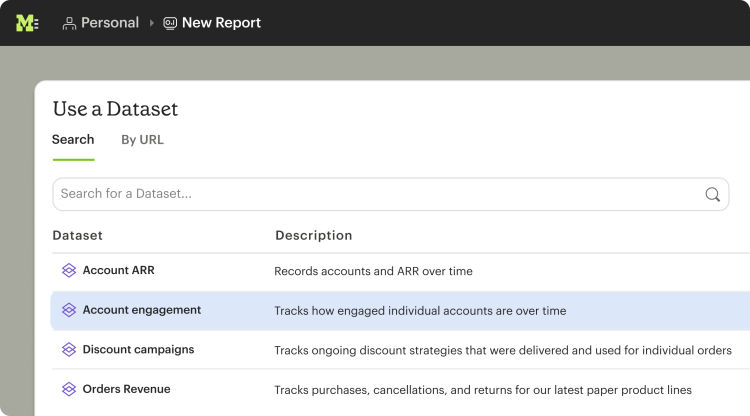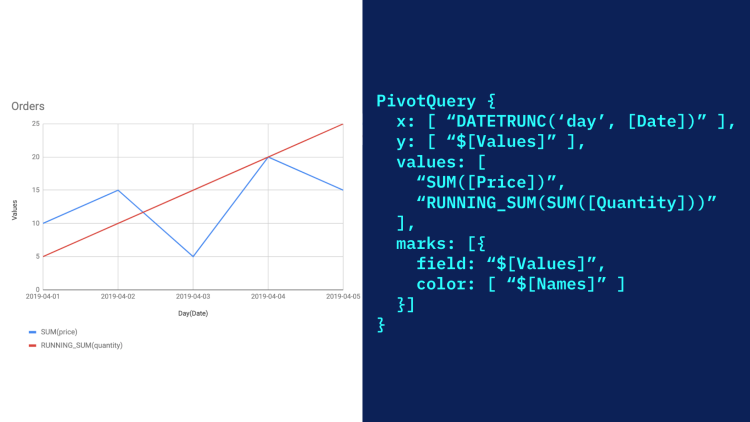Now Live: Datasets, Curated Building Blocks for Self-Service Data Exploration

Samantha Novak, Product Design Lead
December 4, 2022
NaN minute read

See what's new with Datasets!
Meet Datasets.
Today, we are announcing that our newest foundational feature, Datasets, is now live. Datasets are curated, verified tables of data with the dimensions and measures teams need to access and explore relevant data, every day. In Mode, data leaders can now centralize logic, reduce repetitive data requests, and decrease hits to the warehouse while powering self-serve reporting and data exploration for every team.
Using data to make decisions is a critical skill set for everyone. And while businesses today have plenty of data, teams aren’t always using it to make effective decisions; according to Harvard Business Review, only 13% of executives believe their organizations are delivering on their data strategy.
One of the reasons for this is that the people in charge of making daily decisions don’t have access to the right data in the right way at the right time. This challenge could present in a few different ways:
A business leader sees something on a report or a dashboard that doesn’t look as expected. When they try to dig into the data themselves, and the model doesn’t cover the cut that they think could be the culprit based on their contextual knowledge of what’s happening, they hit a dead end. The person who prepared the dashboard didn’t anticipate this dimension or measure–and how could they, the business is always evolving.
A business team relies mostly on its own analytics tools (think Google Analytics for marketing teams, or Salesforce for sales teams) to make its decisions. When they need to bring in data that lives somewhere else, like product data, they run into another dead end. It’s back to the data team, who has to play catch up to figure out what is going on, usually from a combination of tools that all have different proprietary calculations that they’re not familiar with.
A business team relies entirely on data teams to answer all of their business questions. This is unsustainable for analysts, and, if they can’t turn around answers fast enough, the business team ends up making a decision without any data at all.
Without a way for data teams and business teams to collaborate in a single tool to define and explore the data they need to answer not just their first question, but all of the inevitable follow-ups, decisions will be made with inaccurate, outdated, insufficient data—or none at all. Not only that, data leaders will be outside of the data strategy entirely because a business decision can’t always wait for the perfect analysis.
In modern businesses, department leads may not be data scientists, but they are the subject matter experts on their own data. They want to be able to build their own reports, do their own deep dives, and find their own answers without relying on data teams every time—just as much as the data leaders don’t want their analysts bogged down by repetitive questions that business leaders can answer themselves.
Datasets are here to bridge the gap between data teams and business teams, in a way that empowers everyone to move fast, towards insights and action.

Mode's Live Weekly Demo
Join our group demo to get a communal walk-through of Mode!
Datasets power data exploration and self-service reporting for every team
With Datasets, data teams create reusable, centralized, and trusted sets of data, purpose-built for specific use cases across the business, far more quickly than what’s required to maintain business logic in other BI tools. A dataset, with the dimensions and measures needed for self-service exploration, is defined with SQL. Unlike data modeling in legacy BI tools (always rigid and quickly out of date), Datasets can be built right from ad hoc analysis since it’s all defined in SQL.
With Datasets, business teams have a code-free starting point to explore myriad questions and even build their own reporting. Because the most valuable Datasets are built with the business team’s input from the beginning, all the different cuts of data they might need are there.
And, as the business evolves, data teams can quickly update the Dataset in one central place and propagate changes out to its users. The logic keeps pace with the ever-evolving business context.
“If you’re the one who needs to figure out why something spiked last week, you have to go deep—a basic line chart isn’t good enough. With Datasets, we can give our Operations team the level of detail they need to self-serve, in a way that can be easily updated by our team in one place.“
The flexible governance modern data teams need
With multiple options for self-serve analytics spanning a range of governance approaches, Mode enables you to evolve your approach to governance as your business evolves—or even change it based on the data, teams, and specific metrics you care about.
Mode’s integration with the dbt Semantic Layer provides one solution to this problem. Data teams can codify business metrics in dbt, and use the Semantic Layer to make them automatically available in Mode for business teams. This solution provides analyst-friendly, yet relatively strict governance that data teams require for critical metrics that need to be right 100% of the time, such as ARR, net dollar retention, active seats, and other core company KPIs.
Outside of these core defined business metrics, there are many scenarios in which business teams need access to wider, more explorable sets of data—marketing, operations, sales, product data. This is where Datasets comes in. Datasets are for those times when you don’t need the rigidity of the Semantic Layer, but still want the data teams to centralize, curate, and manage the data that business teams are using to make decisions.
Until now, flexibility and governance have been at opposite ends of the spectrum in the data ecosystem and legacy BI tools have over-indexed on governance. Now, Mode enables analysts to create metrics in dbt, curate Datasets in Mode, and make all of this business logic available to teams across the org to drive their own self-serve reporting.
Try Datasets
This release is a major step forward for Mode, and we’ve got more on the way to make self-serve exploration even more intuitive for folks coming from the land of spreadsheets. Our goal is for data teams to be able to send a dataset to their business stakeholders, and know that those teams can take it and run with it – confidently. Until then, we’ll consider this feature in Beta – and we’re thrilled to build towards this future with you.
Get our weekly data newsletter
Work-related distractions for data enthusiasts.




